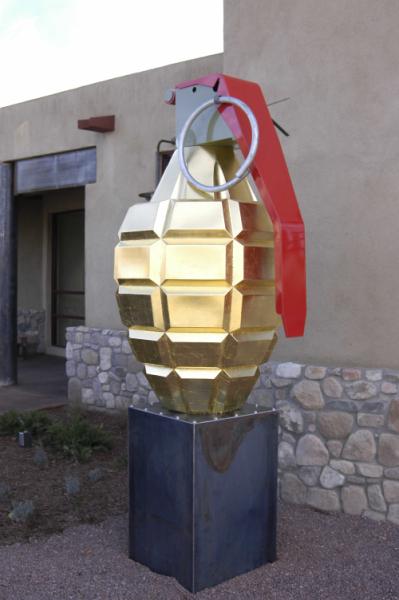|
|
Mammoth-Sized Munitions: Art for the Ungilded Age December 11, 2006 Helen Gaussoin Martin Cary Horowitz's art tends to provoke strong reactions, both from those who see the gilded, often oversized, munitions as promoting war and those who see them as a protest. "It's very interesting, some see them as lefty and some see them as righty," he said last week. "Some see them as the glorification of war materials. Some see them like I do: We don't want to blow up the world. We want to stop the world from blowing up." His latest armament, in front of Linda Durham Contemporary Art on Paseo de Peralta near Acequia Madre, is sticks of dynamite wrapped together with gilded barbed wire. Its installation in front of the gallery follows the display of the oversized round, black "acme" bomb with a gilded fuse and the thrice vandalized, fully gilded, man-size grenade that first attracted attention from the public. Sean McGarrity, a spokesman for the gallery, said Horowitz's art tends to elicit two responses: hate or love. "It's real political, and some people think art should be kind of benign, like the art you see on the walls when you are waiting to see your dentist," he said. Horowitz, he said, by taking destructive objects and turning them into art objects, is trying to say that weapons are just tools. Although McGarrity said the gallery has received few complaints about the public art, one neighbor objected that the acme bomb conflicted with the peacefulness of the neighborhood, and one critic did make his or her feelings known by vandalizing the grenade, installed just before the November 2004 presidential election. "It certainly causes people to rubberneck. People kind of slow down when they drive by to check things out," he said. Horowitz, owner of Gold Leaf Framemakers and trained in a renaissance gilding technique, said he became interested in using munitions for art when his son was in junior high about 10 years ago. "They weren't teaching him anything about Vietnam or Korea and just a little about World War II, which kind of blew my mind," he said. During the Vietnam War, "I was marching in New York City while in art school, getting beat up by the guys in black suits with black Plexiglas shades over their faces and helmets and billy clubs. I ended up fighting the war in the streets of New York. He wasn't getting the proper information on what happened in that war. There was a revolution." With the notoriety of napalm in mind, Horowitz tracked down an empty 10 1/2-foot-tall "incendiary bomb," the kind used to carry the flammable napalm, in Kansas and went to work covering it with gold leaf. "If I gild them, then no one is apt to blow them up," he said. That doesn't stop the vandals, though. While the acme bomb was untouched, the grenade, which has been in shows around the country, has been vandalized three times and had to be repaired and re-gilded. "That is the right and the left of it all. Now you're talking about art. If that statement that I've made and put out in the public eye can be seen in so many different lights, then indeed, I have won as an artist," he said. He won't predict if anyone will damage the TNT. "I never expected anything with the grenade," he said. Copyright © 2006 Albuquerque Journal
|

